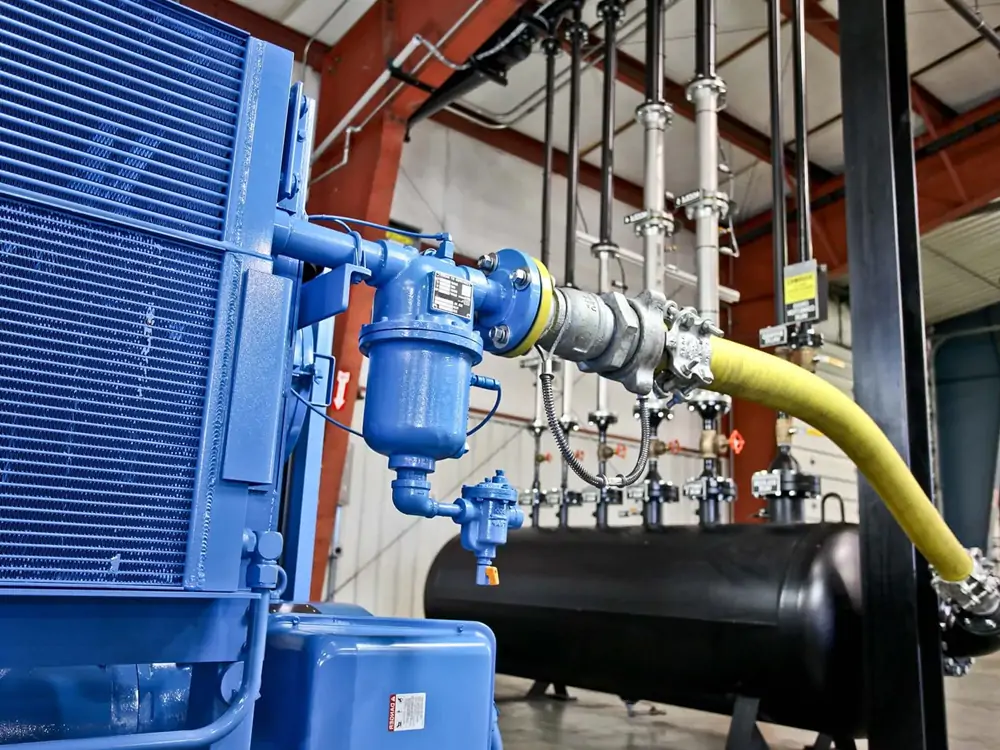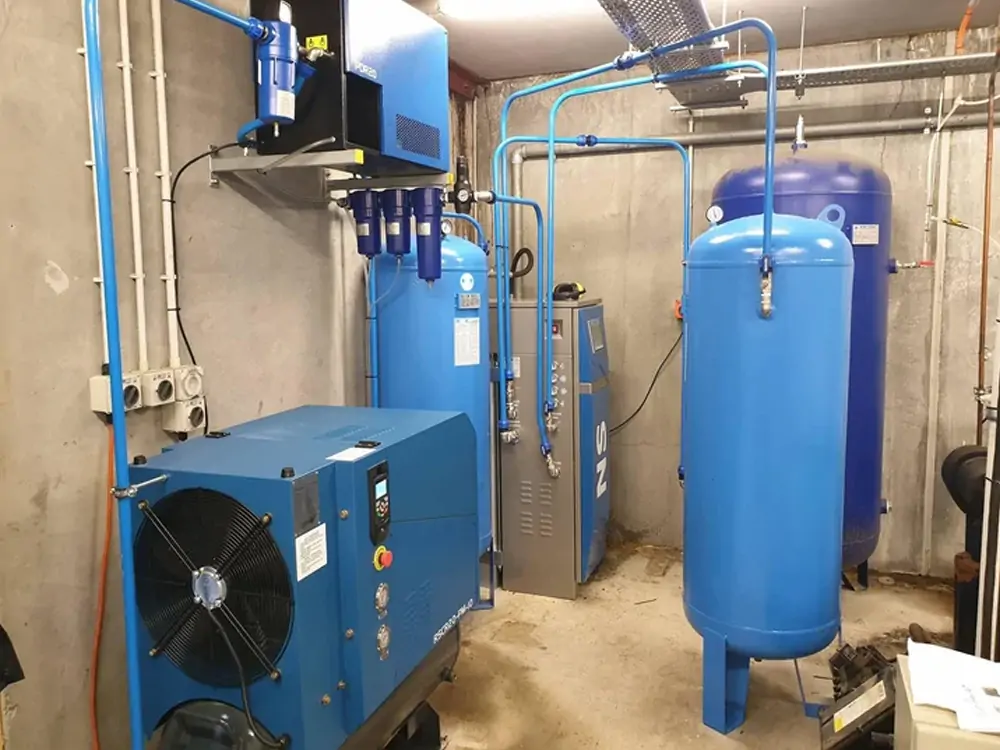When discussing industrial manufacturing or other applications requiring compressed air, air quality is an often overlooked but crucial element. We often focus on ensuring our compressed air systems provide enough pressure to drive equipment. But we rarely consider the humidity and purity of the air. This is where compressed air dryers become essential.
This article explores why compressed air dryers are indispensable equipment in many situations. We’ll look at when you might need a compressed air dryer. Whether you are an industrial manufacturer or use compressed air daily, this article will help you better understand why you should consider investing in a quality compressed air dryer. Let’s explore how this seemingly small but important device can have a profound impact on a variety of applications.
Where Does The Water in Compressed Air Come From?
A umidade no ar comprimido vem principalmente da atmosfera. Isso é inerente ao ar natural. Independente da época, the atmosphere has a certain relative humidity. Além disso, após compressão ou resfriamento, the water vapor in the air will become liquid. Isso afeta a qualidade do ar comprimido.
In industrial air compressor applications, many users are very sensitive to moisture. Since we can’t eliminate the water before the air compressor, it must remove moisture in the compressed air treatment system.
Antes de entrar no compressor de ar, a umidade do ar é principalmente vapor de água. E é insaturado. Como mostrado na planilha 1, a umidade relativa do ar é 69%, e a temperatura é 20°C. Após a compressão (7 bar), o vapor d'água no ar comprimido fica saturado devido ao resfriamento do resfriador traseiro do compressor de ar. E 42% de água líquida será precipitado. A gas-water separator and storage tank can remove this liquid water. O restante 58% of water is in the compressed air as water vapor.
Se não houver secador de compressor de ar, the direct use of compressed air will be bad for production. Portanto, refrigerated and desiccant air dryers have become the preferred air treatment equipment.
Existem três requisitos gerais para o teor de água do ar comprimido.
① The air compressor discharges compressed air. Se houver um resfriador + receptor de ar, then it can lower the temperature by 3 para 10 ℃. This can meet customers with low-quality air, como plataformas de perfuração, canhões de ar, etc.
② But most industrial enterprises generally have such requirement :10℃>ponto de orvalho de pressão>0℃. This requires using an air compressor refrigerated dryer to remove the water vapor.
③ If the need for dew point ≤ 0 ℃, choosing a desiccant air compressor air dryer is necessary. The common dew point requirements for adsorption compressed air dryers are -20℃, 40℃, and 70℃.
What Are The Specific Problems That Arise?
O compressor de ar descarrega o ar comprimido, mas não é limpo. There are many contaminants, como umidade, particulas sujas, óleo, etc. They will enter the production process if they are not purified and dry. Além disso, muitos compressores de ar de parafuso são do tipo óleo. This leads to many problems.
Production Capacity Decline
If there is no air dryer compressed air, umidade, and oil will clog and rust pneumatic equipment and tools. Isso causa operação lenta. Além do mais, linhas e peças entupidas levarão a uma pressão mais baixa. E as ferramentas perderão eficiência. In a long time, o equipamento vai quebrar. Em casos graves, isso pode levar à paralisação da produção.
Increase Product Defect Rate
O alto teor de água no ar comprimido leva a um aumento na taxa de falhas do produto. Por exemplo, spray painting and electronic product processing. Em máquinas de corte a laser ou plasma, a umidade poluirá as lentes em nossas cabeças de corte. Então, it will directly affect the cutting efficiency.
Além disso, various influence exists in the food industry. O ar comprimido geralmente desempenha um papel importante na embalagem e transporte de alimentos. Também, ar comprimido frequentemente entra em contato com o produto.
Se não houver secador de ar com compressor de ar, then much moisture or oil can damage our food. Especialmente na indústria de alimentos secos, existem requisitos mais rigorosos para a umidade do ar. As normas ISO têm diferentes classes para a qualidade do ar comprimido na indústria alimentícia. Different levels have different contents of solids, água, e óleo.
Air Aerodynamic Loss
A água no ar comprimido irá corroer os tubos. Isso leva ao bloqueio do tubo. Além disso, mixing water, óleo, and dust can exacerbate blockages. Além do mais, em regiões frias, o congelamento da umidade pode causar o congelamento dos tubos. Então a pressão cai e a diferença de pressão é grande. Eventualmente, it will affect the safety of production. Além disso, it will lead to air leakage from the pipeline in serious cases.
Por isso, precisa do secador de ar comprimido refrigerado e secador de compressor de ar dessecante para remover a água.
Increase Production And Maintenance Costs
Umidade e óleo irão danificar diretamente nossos componentes pneumáticos. Além do mais, they will also corrode our equipment. Então temos que substituir as peças de reposição por novas. Isso aumenta tanto o custo de manutenção quanto o custo do tempo de produção.
To improve compressed air quality, you must install precision filters to remove oil and water. Então, install an air compressor air dryer to remove the water deeply. Isso traz o ponto de orvalho para atingir os requisitos da aplicação.

What Can Compressed Air Dryers Bring You
A compressor air dryer is a device used to process compressed air. It improves compressed air quality by removing moisture and other impurities from the air. Below are some of the main functions the air compressor dryer can perform.
Dehumidification
Compressed air often contains significant amounts of moisture, harming many applications. Compressed air dryers remove moisture from the air through technologies such as cooling, adsorção, or membrane separation. This prevents moisture from corroding, icing, or other problems with equipment and processes.
Purify
The air may contain particulate matter, grease, bacteria, and other impurities. These impurities can cause problems in some sensitive applications. Air dryer compressed air can filter these impurities and provide cleaner and purer compressed air.
Improve System Efficiency
Dehumidification and purification of compressed air can improve the efficiency of compressors and pneumatic equipment. Dry air transports energy more efficiently, reduces corrosion on pipes and equipment, and reduces maintenance costs.
Extend Equipment Life
Compressed air dryers can extend the life of compressors, valves, and other critical components by reducing damage to equipment from moisture and impurities, downtime, and repair costs.
Ensure Product Quality
In some manufacturing processes, compressed air is used to carry raw materials or participate directly in the manufacture of products. If the air contains moisture or contaminants, this may adversely affect product quality. Air dryer compressed air ensures that products are free from contamination and meet quality standards.
When Do You Need A Compressed Air Dryer
There are many situations where you might need an air compressor dryer. It depends on your application and environment. Below are some common situations.
Pneumatic Equipment
If you work with pneumatic tools, control systems, or machinery, dry compressed air is essential to their proper operation. Moisture can cause stuck valves, leaky cylinders, or tool failure.
Precision Manufacturing
In precision manufacturing, such as electronics, semicondutor, or optical manufacturing, tiny water droplets or particles in the air can cause damage to products. The air compressor dryer ensures the required air quality during production.
Food And Pharmaceutical Industry
In food and pharmaceutical production, hygiene standards are very strict. Moisture and contaminants can pose a threat to product safety and quality. Dry compressed air helps avoid these problems.
Cooling And Freezing Applications
In cooling and freezing systems, dehumidified compressed air helps prevent freezing and frost and maintains stable system operation.
Painting And Coating
If you use compressed air in automotive painting, woodworking, or other coating applications, umidade, and oils can adversely affect the quality of the coating. A compressed air dryer ensures uniform coating and good quality.
Gas Production
Certain gas production processes require extremely high-purity gases, and dehumidification and purification of compressed air are key steps in producing high-purity gases.
Avoid Pipeline Corrosion
Moisture and contaminants can trigger corrosion in pipes and vessels. This may cause leakage or damage to the equipment. Compressor air dryers protect equipment and infrastructure from such hazards.
Energy Saving
Dehumidified compressed air requires less energy to transport. Drying air, therefore, reduces energy costs and increases system efficiency.

Conclusão
Neste artigo, we dig into the importance of air compressor dryers and when to consider using them. Whether it is industrial manufacturing, precision manufacturing, food processing, pneumatic equipment, or other applications, compressed air quality is one of the key factors in ensuring system efficiency and product quality.
A compressed air dryer can be a seemingly small and easily overlooked device. But it is critical to many industries and applications. Ensuring your compressed air is of the right quality can increase productivity, reduce maintenance costs, and ensure product quality. Então, whether you need a compressed air dryer depends on your needs. But considering them is often a smart choice that can provide lasting benefits to your workflow and business.
